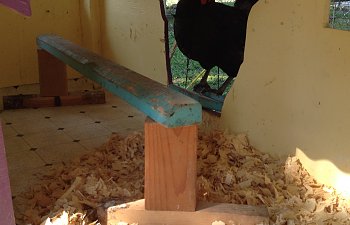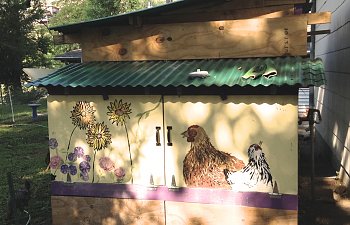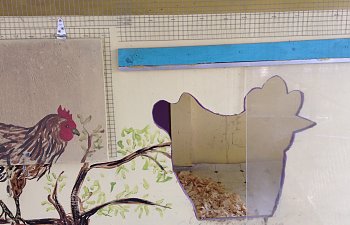Being new to chickens I looked at many designs and many feed store mini houses and hubby and I determined we needed to build our little chick mansion ourselves. At the time we lived in New Mexico which is hot, windy and very dry. The ground is cement dust with nothing living in it and Great Horned Owls and Coyotes and boredom were the main threats other than the heat. We have since moved to Colorado and there are different concerns so adjustments to the coop have been made.
We started with a dog run. 5 x 5 panels are easiest to move and configure. The raised sleep/nesting area was made for the NM 10 x 10 dog run so we had to reconfigure it for Colorado (logistics of moving it.) It is 6 feet long and about 3.5 feet tall and stands not-far-enough off the ground (I hit my head on the roof when cleaning it-- it was too tall for the U-haul). Because it was longer than the new 5 foot panel we ended up with a funky shaped pen that is working out fine. We used to have a little porch that was attached to the sleeping area door that the ramp was attached to. For Colorado we decided we didn't want a predator staging area so we removed the porch and at night I pull the ramp off and slide the plexiglass door to close them in.
The inside of the sleeping are is painted wood with linoleum for ease of cleaning (keeps moisture from getting into the wood and makes it easy to roll and funnel the shavings into a cement mixing tray when I want to clean it. The back wall is two fold down panels to facilitate cleaning. There is ventilation along the entire top with two large windows on the sides. The nest box has an egg gathering or push-out-the-broody-girl flip up panel.
Chain link allows you to put perches in the corners and boards that support the chicken wire and fiberglass roof allow you to suspend nipple bucket waterers, food, cabbage tetherball devices and swings (if yours will use them - mine are afraid). In NM we had misters suspended as well but they were afraid of them!
What we like:
1) easy to clean because of the fold down doors
2) linoleum is cheap and makes clean up easy
3) since the sleeping area is elevated you can use underneath it as a place to isolate a sick or in our case broody girl, and you can plywood it up during the rainy season or use wire when you want air flow
4) chain link is stable and a great think to attach hardware cloth to and add perches, shade cloth, fun and wire to
5) hatch allows egg getting from outside the coop (coop front lines up with the chain link so the main part of it is actually outside the large area - you could put it entirely inside but would place your nest box elsewhere)
6) I enjoyed painting a scene on it and having the door cut like a chicken profile (makes it happy!)
What we don't like
1) make the sleeping area tall enough that you don't hit your head (we had to cut it down so it would fit in the U-haul
2) it may be better to have the nesting boxes underneath the sleeping area so we could have more- the hens all like the one box and won't go in a second one I put in.
3) we used to have a water bottle in the sleeping area and it dripped so we took it out (they don't need water when they sleep
4)it would be easy to make the windows and other areas easier to convert during different seasons
Things that have worked well:
1) using a cement mixing tray with sand for a winter dust bath area
2) when things get mudding buy a square of turf to lay down ( builds the area up and they can peck at it)
Plans:
1) add more chain link panels to make a larger covered outside run area and make another layer a predator would have to go through to get to the door (which would be inside the enlarged area)
2) maybe use a baby monitor so we can hear what's happening at night
3) might have to consider the not welcome bear mat thing
We started with a dog run. 5 x 5 panels are easiest to move and configure. The raised sleep/nesting area was made for the NM 10 x 10 dog run so we had to reconfigure it for Colorado (logistics of moving it.) It is 6 feet long and about 3.5 feet tall and stands not-far-enough off the ground (I hit my head on the roof when cleaning it-- it was too tall for the U-haul). Because it was longer than the new 5 foot panel we ended up with a funky shaped pen that is working out fine. We used to have a little porch that was attached to the sleeping area door that the ramp was attached to. For Colorado we decided we didn't want a predator staging area so we removed the porch and at night I pull the ramp off and slide the plexiglass door to close them in.
The inside of the sleeping are is painted wood with linoleum for ease of cleaning (keeps moisture from getting into the wood and makes it easy to roll and funnel the shavings into a cement mixing tray when I want to clean it. The back wall is two fold down panels to facilitate cleaning. There is ventilation along the entire top with two large windows on the sides. The nest box has an egg gathering or push-out-the-broody-girl flip up panel.
Chain link allows you to put perches in the corners and boards that support the chicken wire and fiberglass roof allow you to suspend nipple bucket waterers, food, cabbage tetherball devices and swings (if yours will use them - mine are afraid). In NM we had misters suspended as well but they were afraid of them!
What we like:
1) easy to clean because of the fold down doors
2) linoleum is cheap and makes clean up easy
3) since the sleeping area is elevated you can use underneath it as a place to isolate a sick or in our case broody girl, and you can plywood it up during the rainy season or use wire when you want air flow
4) chain link is stable and a great think to attach hardware cloth to and add perches, shade cloth, fun and wire to
5) hatch allows egg getting from outside the coop (coop front lines up with the chain link so the main part of it is actually outside the large area - you could put it entirely inside but would place your nest box elsewhere)
6) I enjoyed painting a scene on it and having the door cut like a chicken profile (makes it happy!)
What we don't like
1) make the sleeping area tall enough that you don't hit your head (we had to cut it down so it would fit in the U-haul
2) it may be better to have the nesting boxes underneath the sleeping area so we could have more- the hens all like the one box and won't go in a second one I put in.
3) we used to have a water bottle in the sleeping area and it dripped so we took it out (they don't need water when they sleep
4)it would be easy to make the windows and other areas easier to convert during different seasons
Things that have worked well:
1) using a cement mixing tray with sand for a winter dust bath area
2) when things get mudding buy a square of turf to lay down ( builds the area up and they can peck at it)
Plans:
1) add more chain link panels to make a larger covered outside run area and make another layer a predator would have to go through to get to the door (which would be inside the enlarged area)
2) maybe use a baby monitor so we can hear what's happening at night
3) might have to consider the not welcome bear mat thing







